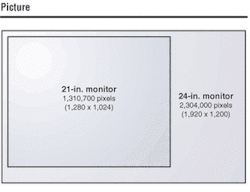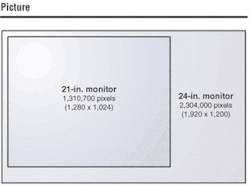Wide screen format monitors enhance interpretation
Will Morse
Anadarko Petroleum Corp.
Long ago, or so it seems, geophysicists would work seismic interpretation projects on long sheets of paper. An advantage of these long sheets was that geophysicists could see most of the section in one view. They could fold the paper, peer down the paper to form an angle to visually alter the aspect ratio or to help visually correlate horizons across faults, and use other methods to help them see the relationships in the data. All this radically changed as seismic interpretation moved to the computer workstation.
Geophysics
Seismic interpretation involves a lot of data displayed at one time. Standard 21-in. monitors have a 1,280 x 1,024 pixel viewing area for a total of 1,310,720 pixels. Anadarko Petroleum has started deploying wide screen, 1,920 x 1,200 pixel displays in 24-in. monitors for a total of 2,304,000 pixels. Anadarko previously gave a geophysicist two 21-in. monitors. Two 24-in. monitors are effectively slightly larger than three 21-in. monitors.
- Three 21-in. monitors – 3,932,160 pixels
- Two 24-in. monitors – 4,608,000 pixels
Geophysicists find they are able to view more of the seismic line on a straight surface without the monitor frame and alignment complicating their view. This makes it easier to interpret horizons and to make decisions about continuing horizons across faults. It gives the interpreter a better big picture around the points he is trying to interpret. It also makes it easier to include more information such as well bores, cultural data, log traces, and other information in the picture without crowding out the seismic. Since a wider presentation is available on each screen, the interpreter does not have to scroll or access additional data as often, providing fewer interruptions in the interpretation thought process.
More information
Geologists also benefit from the 24-in. monitor because they can include more information on a single screen. A geological cross section with 12 wells and two log traces per well can get crowded on a 21-in. screen.
Both 21-in. and 24-in. monitors are available as cathode ray tubes (CRTs) or liquid crystal display (LCD) flat panels. CRTs are heavier and consume a larger footprint on the desk, but are less expensive. The new LCD flat panels are much thinner and lighter. Fitting two or three monitors on an exploration desktop along with paper maps, logs, reference material, and so on can be a challenge. Some LCD monitor stands provide room under the monitor to hold the keyboard. The main limitation of current LCD monitors is that they cannot support "stereo" 3D viewing. For this you need a CRT.
Advantages
User experience at Anadarko Petroleum has been positive. Users report that they spend less time waiting for the screen to redraw when they move the scroll bar for the seismic line. This comes from both having more data on the screen, less need to redraw, and from the overall faster redraw of the SunBlade-1000 and Expert3D graphics.
Having more data displayed on the two monitors gives the geophysicist or geologist a larger picture of the correlation of interest (horizon). It is easier to tie a horizon to a distant well because the screen can show a longer seismic line in more detail. A well track or cultural data boundary is "thinner" because it uses lines only one pixel wide. With more total pixels, the well track does not obscure as much seismic data. The interpreter can put more well, log, or culture data on the screen and still see enough seismic to draw horizons.
Stereo 3D images benefit greatly from the larger screen. A stereo image supplies one part of the graphic to the left eye and another part to the right eye using special glasses. The cost of this is an overall reduction in resolution of the picture. Having half-again as many pixels on the screen makes it easier to show a meaningful amount of data in 3D.
Disadvantages
A disadvantage to the 24-in. monitors is that the pixels themselves are smaller. Menus and fonts that are barely readable on a 21-in. monitor become unreadable on a 24-in. monitor. This has not been a problem for Anadarko using exploration software, but can be a little annoying using Internet web browsers, email tools, and other text-oriented software.
Software limitations
Many of Anadarko's third party applications cannot take advantage of more than two monitors except by using Xinerama, a function that makes both monitors appear to be one large monitor to the application. There is one problem. When Xinerama is used, both monitors share a synchronized color pallet.
Many exploration applications require an 8-bit (256 color) pallet, even if the system is capable of 24-bit (16,777,216 colors). This is a limited set of colors. The best way to solve this is to have a wide screen projection system on adjacent, blended screens, which Anadarko does in its Image Delivery Enhanced Awareness visualization/collaboration workrooms. This is too costly for the desktop, however.
Hardware requirements
To make effective use of the wide screen format monitors, Anadarko equips its SunBlade-1000 workstations with two Expert-3D framebuffers graphics cards. The older Creator Graphics and other cards cannot drive the 24-in. monitors. There is an Expert-3D Lite framebuffer, but Anadarko's testing indicated it is inadequate for seismic interpretation use.
Anadarko also chose the SunBlade-1000 be-cause it can hold 8 Gb of RAM and two 750-Mhz or 900-Mhz processors. There is no point in having fast graphics if the processor and RAM cannot provide the picture. Anadarko is also in the process of deploying gigabit ethernet network connections to better use its network attached storage.
Conclusions
Productivity in geophysical and geological interpretation has a lot to do with seeing as much data as possible in a workable format. Two 24-in. monitors display more data than three 21-in. monitors, and with better continuity. The interpreter can see more data at a time, and does not need to refresh his data as often, leading to faster and better interpretations.

